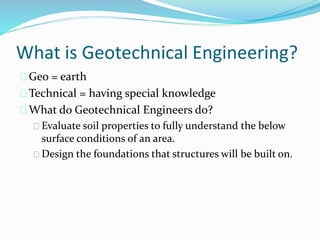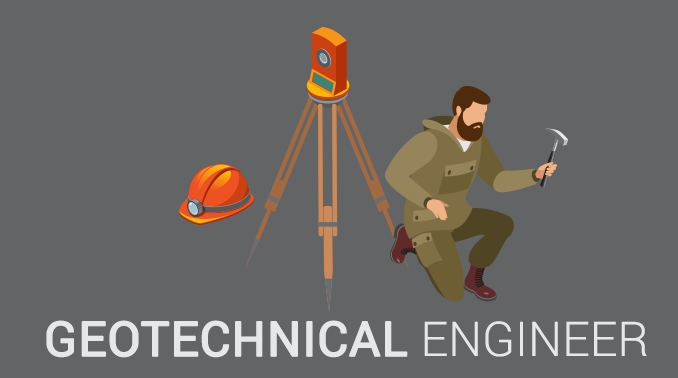Geotheta Fundamentals Explained
Geotheta Fundamentals Explained
Blog Article
Indicators on Geotheta You Should Know
Table of ContentsThe Main Principles Of Geotheta The Only Guide for GeothetaThe 6-Second Trick For GeothetaThe Main Principles Of Geotheta
They work together with civil engineers, structural designers, designers, and other professionals to incorporate geotechnical factors to consider into the overall project layout and building and construction procedure. This calls for reliable synergy, control, and communication to guarantee that the geotechnical facets align with the task goals and meet regulatory demands.Mining & Materials Design: Principles of boring, infiltration rates, and aspects affecting the option of drilling method. Blasting techniques in surface and below ground functions. Mechanical and continual methods to fragmentation, consisting of longwall shearing and fullface boring.
Modelling of fragment and fragment size distributions; comminution as a transfer feature. Comminution technology: squashing, grinding, dimension category. Integrated analysis of fragmentation and comminution procedures. Supplied by: Mining & Materials Engineering.
Fascination About Geotheta
Bachelor's level programs in civil, geotechnical, geological, and ecological design normally last 4 years and include basic education and learning programs in English, social scientific research, and the humanities, in addition to training courses in innovative maths, architectural geology, and liquid mineralogy. (https://geotheta.carrd.co/)
Geotechnical engineering entails the assessment of the soil and rock conditions at a certain website, and their implications for the advancement of that website. As the majority of structures depend on the ground for assistance, it lacks surprise that an in-depth understanding of the ground problems, and the suitability of foundation systems, are important to the lasting stability and performance of the building or structure.
Specialising in the investigation of geological formations and ground behavior, geotechnical designers do clinical examinations and screening to recognize the impact these geological formations might carry the design and building and construction of structure, civil and infrastructure projects. This experience is important for the design and construction of buildings, roadways, passages, dams, bridges, and water system and sewer systems.
The geotechnical team at Douglas Partners regularly consult with architects, design designers, programmers, and builders to make recommendations on layout and growth proposals to make certain that the constructed frameworks are appropriately designed for the ground conditions. The design of footing systems requires to think about the weight of the structure, the ability of the ground to sustain that weight together with movement resistances and efficient building and construction.
The Greatest Guide To Geotheta
This job is considerably streamlined by the use of our Douglas Map geospatial system which makes this info conveniently easily accessible in an easy to utilize internet internet browser interface. A geotechnical designer will guide the exploration of boreholes and test pits to gather dirt and other samples, and likewise analyze surface features and ground direct exposures to form a geotechnical design of the subsurface problems.
Depending on the job kind and ground problems encountered, lab screening might to name a few things examine toughness, compressibility, reactivity and/or permeability of soil and rock samples. After this data is accumulated and collated, the outcomes are utilized for a geotechnical version of the site, which is commonly presented as sections across the site.

A geotechnical examination naturally can just evaluate the ground conditions at the places pierced or dug deep into. All-natural variations in soil and rock conditions can occur across a website and in between examination areas. It is consequently excellent technique that the geotechnical designer be preserved throughout building and construction of the task to give on-site confirmation that the ground problems run into follow the assumptions and suggestions supplied in the geotechnical examination report.
An Unbiased View of Geotheta
Geotechnical engineers utilize their comprehensive understanding of soil and rock to analyze danger and resolve problems on varied infrastructure projectsGeotechnical design is a specialist branch of civil engineering which looks at the practices of earth products and the application of soil and rock technicians. Engineer of Record. As a geotechnical designer, you will evaluate the physical, mechanical and chemical properties of dirt and rock in order to develop structures, keeping frameworks and earthworks
Geotechnical engineering is very closely linked to and overlaps with, both engineering geology and ground design - https://www.easel.ly/browserEasel/14498559. It's feasible to specialise in geotechnics or work for a geotechnical firm however be known as an engineering rock hound or a ground designer. As a geotechnical engineer, you'll need to: develop and maintain partnerships with clients and various other experts involved in the website, throughout each projectmaintain security criteria on site be conscious of expense implications when you make recommendationsstudy geological maps and aerial pictures from a variety of resources and from different time periodsexamine building and construction prepares to see just how practical they are based upon your understanding of the siteinvestigate dangers or geological hazards for the sitesearch for ecologically delicate functions, such as land fill start to create factual and interpretive ground modelsplan area investigationsdrill and evaluate samples of bedrock, soil, groundwater and added materials oversee other read the full info here experts on sitesolve technological issues as they develop, such as unexpected structures at drill sitesmonitor problems during and after building to ensure structures are secure in the short and lengthy termadding information gathered on site to your first researchcreating geotechnical calculations, illustrations, and two or three-dimensional computer designs analyzing the datamaking recommendations regarding the recommended usage of the site

Report this page